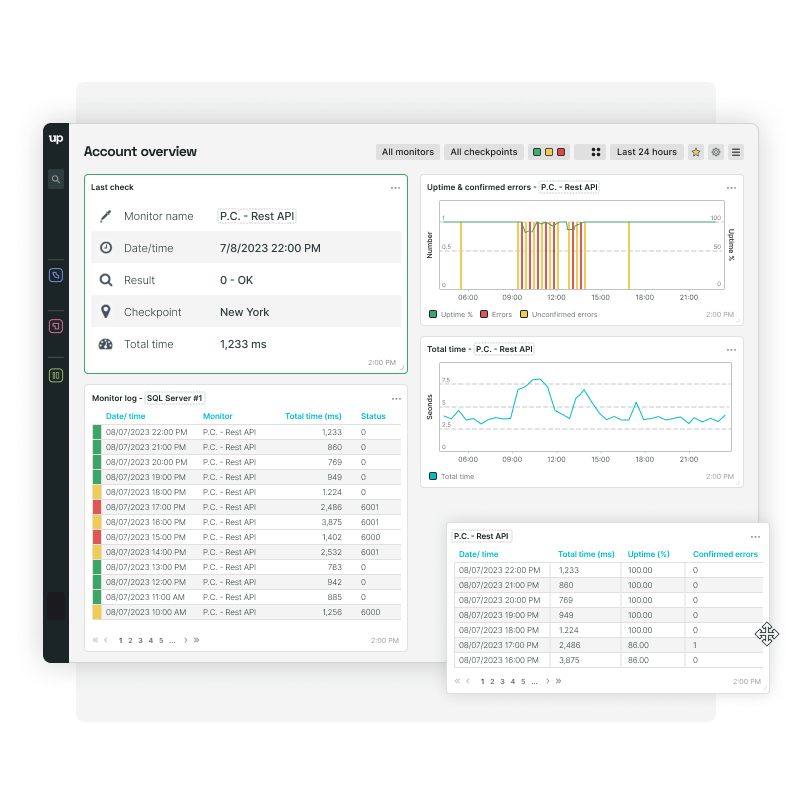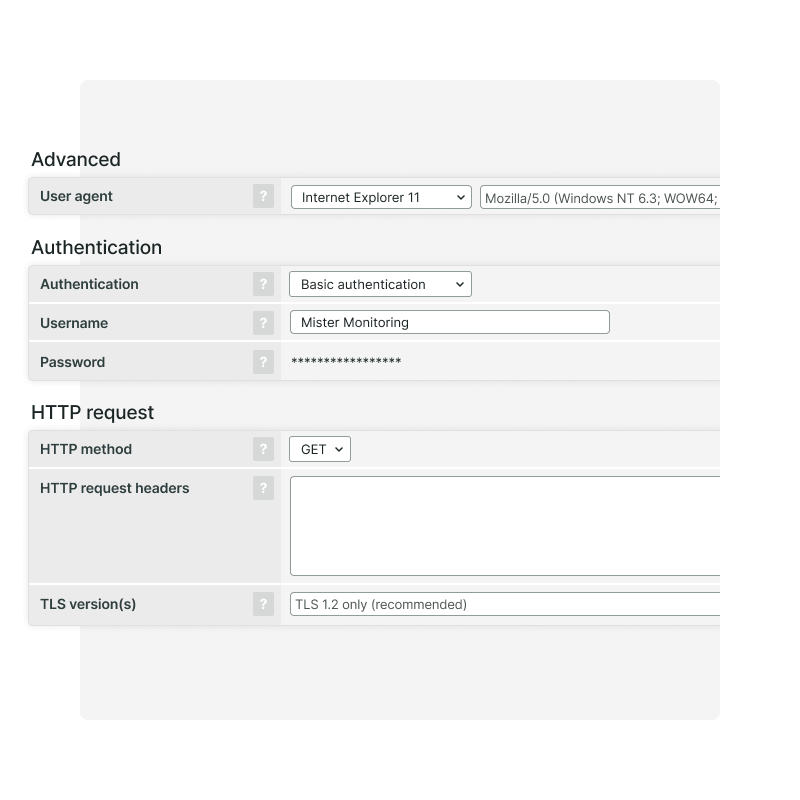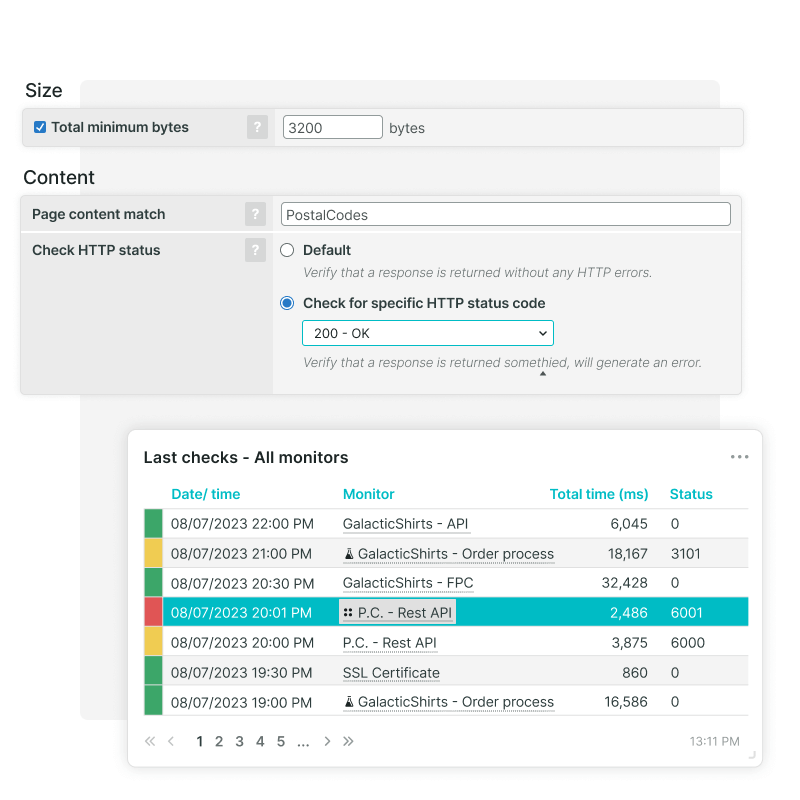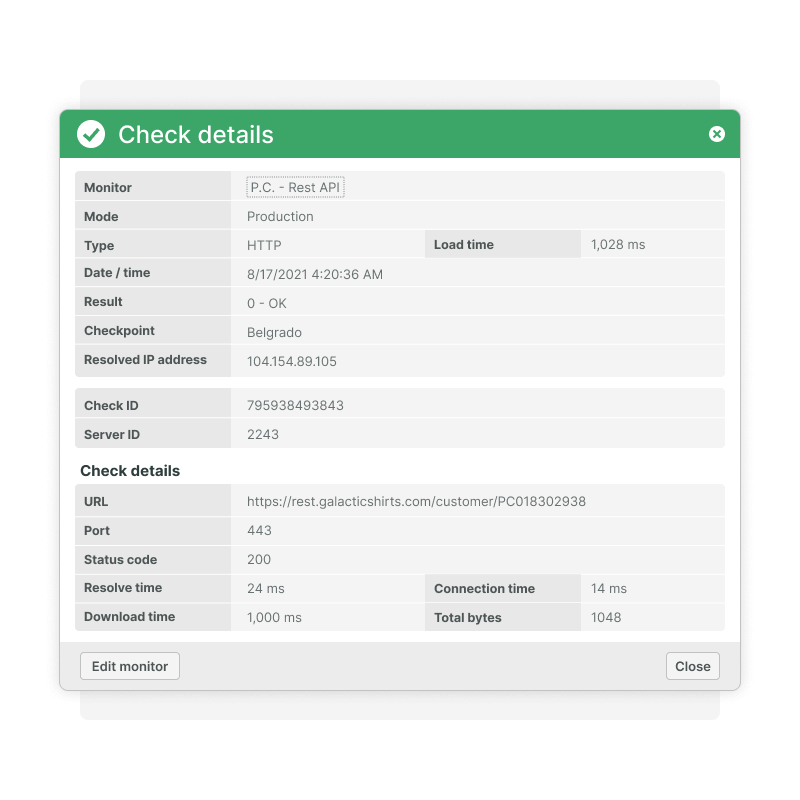Monitor API uptime around the clock
Developers use REST APIs (Representational State Transfer Application Program Interface) to build web services. Using the HTTP protocol, REST APIs enable software on one device to talk to software on another device regardless of the operating systems and architectures used.
Uptrends supports the uptime of web services, such as REST, SOAP, as well as any web services reachable through HTTP/ HTTPS — invaluable for businesses that need API monitoring to protect critical services such as, address validation, credit card processing, reservations or scheduling systems, and more.

Representational state transfer (REST)
REST is a not a protocol or a standard but a set of architectural constraints. API developers can implement REST in a several ways allowing for interaction with RESTful web services. The information is then delivered in one of several formats-HTTP: JSON, HTML, XLT, Python, PHP, or plain text.
Simple Object Access Protocol (SOAP)
SOAP is a standard protocol that was first designed so that applications built with different languages and on different platforms could communicate. It requires XML messaging to monitor different web service specifications, such as WS-security, WS-Reliable Messaging, WS-addressing, and Web services description language (WSDL).
HTTP
An HTTP monitor checks your web pages' availability from designated checkpoints located around the world. Besides checking for basic website monitoring availability, you can set up alerts for page load times, minimum page size, content, and status codes. Your team will be instantly alerted when something’s not right.
HTTPS
HTTPS monitors includes all the options of HTTP monitoring, and more. These monitors can check pages secured by an SSL certificate. When your certificate ever returns an error, it will trigger alerts. Monitor page load times, HTTPS status codes, user agent specification and authentication as well as custom HTTPS requests and posts.
Keep an eye on your API
Testing tools and like Postman, Insomnia, SoapUI or Swagger UI can be used to test your APIs and inspect data for ad-hoc testing and debugging. Another way to monitor availability and response time is to use a synthetic monitoring tool like API monitoring.
Set up in-depth content validation of your JSON data using JSON expressions or XML data so you can really check that the data returned by the API meets your expectations - without errors, and within acceptable boundaries.

Track API data
If you have a REST API that is part of an e-commerce system that sells products, you can create a Multi-Step API monitor to perform one or more calls to your Product API endpoint that returns JSON-formatted data. This is important for you to know the total number of products, product categories, and the number of products in your inventory. If something goes wrong with your supply chain, Uptrends will alert you so you can take swift action.
Detect data trends
Using the e-commerce model to track API data, you can also detect subtle trends occurring on the micro level—those occurring on an hourly, daily, or weekly basis—or a macro level for those occurring at lengthier periods of time. If you’ve already created a Multi-Step API monitor, and identified your metric in the assertion, it’s easy to start collecting its data as custom metric data.
Inspect data and troubleshoot
If you can locate your MSA monitor and find a recent check result, you can click on it to open up the check result popup. Inspect how the value(s) for your new custom metric(s) appear below the step results. This gives you direct access to the individual custom metric values as they were captured during the execution of the Multi-Step API monitor.

“Before Uptrends, we didn’t have insights into our real uptime, but now we do.”
Check Web Services
Uptrends supports REST, and SOAP, as well as any web services reachable through HTTP and HTTPS. By setting up a Multi-step API monitor, you’ll know exactly when your API is or isn’t working correctly.
Start with single steps and build on them later as your scenarios change. Add authentication (Basic/NTLM/Digest/OAuth) or include client certificates to gain access to protected APIs. Define assertion checks for each response. Extract content from the response body, headers, cookies, and more.

Monitor your API availability and performance
Even a short outages can lead to website, app, and device failures. API publishers typically take great care to ensure systems have the proper redundancy to avoid downtime, yet outages still happen. Tests should happen once per minute to maintain high availability. Putting a simple HTTPS/HTTP web service monitor in place is an excellent solution for checking availability.
Uptime monitoring provides assurances that an API responds to requests and how long the response takes. Using a content check and checking the response code reveals if the API responded with the expected result. When errors occur, alerts rapidly notify your team about the problem. Monitors can also report data to back up any SLAs in place.

Try Uptrends REST API monitoring free for 30 days!
Setting up web service monitors for every endpoint ensures they remain available, but endpoint checks may not be enough to prove an API functions properly. Rely on Uptrends’ Multi-step API Monitoring to handle the most complicated API checks for availability, function, and performance.
Get started — it’s free!